April 19, 2013
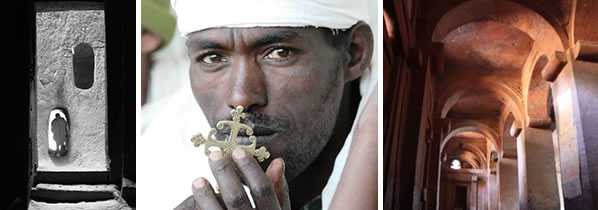
On Easter Day we climbed some 1,600 feet by mule and foot to the 14th-century monastery of Ashetun Mariam. There was a biblical feel to our little procession as we made our way out of the town of Lalibela.
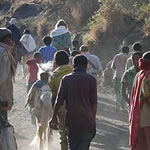 It was a feast day of the Blessed Virgin Mary, and we walked alongside pilgrims swathed in their white gabis accompanied by the inevitable hangers-on associated with tourists or faranji as they are known.
It was a feast day of the Blessed Virgin Mary, and we walked alongside pilgrims swathed in their white gabis accompanied by the inevitable hangers-on associated with tourists or faranji as they are known.
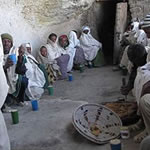 As we climbed we stopped every so often to look back at the naturally protected shapes of the celebrated rock-hewn churches; it was an epic scene. After visiting the monastery we joined the pilgrims who were enjoying some locally brewed honey wine. Later that day we were served a rather more palatable and visually appealing freshly prepared juice of mango, avocado and banana, all for the princely sum of 90 pence.
As we climbed we stopped every so often to look back at the naturally protected shapes of the celebrated rock-hewn churches; it was an epic scene. After visiting the monastery we joined the pilgrims who were enjoying some locally brewed honey wine. Later that day we were served a rather more palatable and visually appealing freshly prepared juice of mango, avocado and banana, all for the princely sum of 90 pence.
The eleven Lalibela churches, whose construction was orchestrated by King Lalibela at the end of the 12th century, are one of the main attractions in Ethiopia. They have world heritage status and took some twenty-five years to build. What makes them so remarkable is the fact that they were in a sense freed from the rocks and are beautifully and expertly carved.
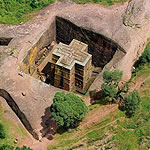 When you stand in front of the first one you find it difficult to comprehend fully the sheer endeavour and skill it must have needed to hew these buildings out of a single piece of rock.
When you stand in front of the first one you find it difficult to comprehend fully the sheer endeavour and skill it must have needed to hew these buildings out of a single piece of rock.
This is Africa’s Petra. Given that this is a Unesco site it is surprising there are not more tourists. I suspect this will gradually change as Ethiopia shakes off its reputation as a famine-stricken country and benefits from more political stability. But one thing is for sure: at religious festivals there are thousands and thousands of Ethiopian people at Lalibela, many sleeping on the ground. This is a deeply spiritual country and mostly Orthodox Christian in the north.
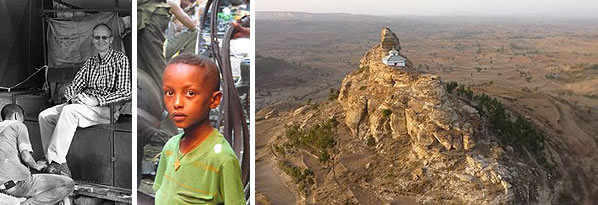
Our guide, Moges, had spent a good few years shining shoes in order to pay for his room whilst at secondary school. The majority of the children attending school here are from rural areas; their families have little or no money and survive by bartering produce at the local markets which are dotted about the rugged countryside.
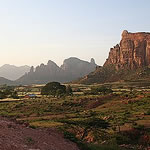 Morges was lucky, because a tourist sponsored him to attend college where he learnt to be a tourist guide. The engaging sales patter and motivation shown by the teenagers if at times a little over insistent would I think be approved of by many business people here!
Morges was lucky, because a tourist sponsored him to attend college where he learnt to be a tourist guide. The engaging sales patter and motivation shown by the teenagers if at times a little over insistent would I think be approved of by many business people here!
Earlier in our tour we had seen some big country in the Great Rift Valley, a geographical trench that extends from the Red Sea down to as far as Mozambique. The Simien Mountains National Park is on the northern edge of the Rift and easily rivals Kenya on the dramatic scenery stakes.
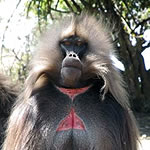 Endemic species such as the Ethiopian wolf, walia ibex and gelada baboon may be seen here. The latter you are sure to see in large numbers, and how it acquired its other name – the bleeding heart baboon – is self-evident from the picture.
Endemic species such as the Ethiopian wolf, walia ibex and gelada baboon may be seen here. The latter you are sure to see in large numbers, and how it acquired its other name – the bleeding heart baboon – is self-evident from the picture.
A big male, with its thick mane, waist length cape of dark fur and handsomely tufted tail, looks in part like a lion, but fortunately you can walk up to them with impunity whilst they eat the grass around you. They are the only surviving species of grazing monkey in the world.
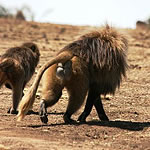 It must be said that there are few luxury hotels in Ethiopia and so the focus needs to be on what you are going to see rather than where you are going to stay! Apart from those fresh juices, traditional Ethiopian food always involves an injera- a sort of grey pancake which you break off and use almost as tongs to scoop up your wot, a spicy meat or vegetable dish.
It must be said that there are few luxury hotels in Ethiopia and so the focus needs to be on what you are going to see rather than where you are going to stay! Apart from those fresh juices, traditional Ethiopian food always involves an injera- a sort of grey pancake which you break off and use almost as tongs to scoop up your wot, a spicy meat or vegetable dish.
Utensils are rarely used, and the mark of a native is that his fingers are never stained by the sauce. Don’t worry if this sounds a little unappetising, as there are also good pasta options; the Italians whilst never fully conquering Ethiopia did occupy it for a few years.
There are many more highlights to be seen on a tour of the historic sites in Northern Ethiopia and indeed the Rift valley.
A full itinerary can be sent on request.
NB prices shown were current at the time of writing the newsletter and are not necessarily current now.
Please ask for an updated quote.
- The Khajuraho temple complex, a Unesco World Heritage Site
- A Sense of Place: Poignancy in KwaZulu Natal
- A Sense of Place: Northern Botswana
- A Trio of Treats in India
- And now for something completely off grid and different: AFRICA’S ULTIMATE RAINFOREST SAFARI
- A Trio of Treats off the beaten track – We get you to places that others don’t!
- A Trio of Treats On The Rift Valley
- A Sense of Place – Can the muppets save a species?
- Trio of treats (Rajasthan, Maldives and Garden Route)
- A Sense of Place – A favourite place: Tanzania and Ruaha
- A Sense of Place – A favourite place in Botswana: the Okavango with elephants galore
- A Sense of Place – Here be dragons and a dark past
- A Sense of Place – Justice Regained
- A Sense of Place – Summer rains make the roads impassable
- A Sense of Place – ‘Those two ladies put light in my future.’
- A Sense of Place – The bird who lost its nest
- A Sense of Place – Talking with the Maasai
- Newsflash: first American guests to Tanzania since March 2020
- A Sense of Place – AFRICA NEEDS YOU
- Escape to Italy?
- Covid: the road still to be travelled.
- A trio of treats. Series of 3 (Part 3): Tiger reserves.
- A trio of treats. Series of 3 (Part 2): Khajuraho.
- A trio of treats. Series of 3 (Part 1): Lucknow.
- A Sense of Place – Engaged people may save the planet
- A word on lions and a trio of treats
- A Sense of Place – India’s most holy city
- A wealth of wilderness walks in Namibia
- Travel snippets from Miles
- A trio of treats on the green island of Pemba in the Zanzibar archipelago
- A Sense of Place – THE INSIDE TRACK on Cape Town guiding
- A Sense of Place – Migrations of people and beasts: East Africa
- A Sense of Place – An era of revolution and global alliances
- A Sense of Place – A walk on the wild side
- A Sense of Place – The ghost ingredient is back
- A Sense of Place – Liuwa Plains and Kafue National Parks – Zambia
- A Sense of Place – Literati in the Pink City, the Capital of Rajasthan
- A Sense of Place – A Tamil town still connected to Europe, Art Deco architecture, and temple antiquity in Southern India.
- A Sense of Place – Dreamy aquamarine sea and stunning safari with the Makuleke people
- A Sense of Place – A trio of lovely ladies in Hyderabad
- A Sense of Place – Entamanu, the wishing tree and walking with the Hadza tribe.
- We get you to places that others don’t… St Helena, Gt Zimbabwe ruins and Papua new Guinea
- A Sense of Place – Walking in the hippie hills of the Himalayas
- A Sense of Place – The Okavango: the river that never finds the sea
- A Sense of Place – The Great Rift Valley, Laikipia, Samburu warriors and Maasai Olympics.
- A Sense of Place – Escape the world in the Namib Desert
- Africa is a massive continent: a collection of 55 countries
- A Sense of Place – Zambezi Watery Wilderness
- A Sense of Place – Burma: the road beyond Mandalay
- Lake Malawi – Would you rather pay for the advertising or the experience?
- From shoe-shine boy to tourist guide in Ethiopia
- A Sense of Place – Ladakh, the Himalayas
- Dhow sailing, Lions are back in Malawi, Self-drive in Namibia
- Sacred rivers and forts, India
- Piranhas, sting rays, caimans – and still people go into the River Negro!
- Kerala, Southern India – God’s own country
- South Africa: Crucible of the rainbow nation
- Madagascar: croissants and lemurs
- Argentina vs Africa on wildlife drama
- Uganda – Gorillas and Gardens
- Mozambique & Kenya: immigration official on holiday
- Mozambique: Gorongosa and reconciliation in the bush
- Zimbabwe is ready for Tourists again
- Serengeti ecosystem and unbeatable savannah
- Lamu: crab complaining
- Kenya: circumcision
- Zambia: Ellie rescue
- Africans: always smiling
- Tswalu
- French sketch
- Kenya: the best hosts
- First visit to Africa 1986
- Namibia, Namib Rand, Skeleton Coast and the ultimate flying safari
- A few gems off the beaten track: Fanjove Island, Tanzania; The Singular Hotel, Patagonia and Isla Palenque, Panama.
- Elephant relocation, quad bike expedition and new Sossusvlei reserve
- Templed out in Tamil Nadu and elephant refuge in Jaipur
- Kenyan sanctuary and family run camp in Zambia
- Australia: Arkaba, Tasmania and Lord Howe Island
- Australia: in the outback and off the beaten track
- India: heavenly Himalayan hideaways, Botswana: fun safari for children and Argentina: hidden homestay in a mountain desert
- Limpopo retreat, Serengeti spectacle and adventure on the Zambezi
- Value for money in Kenya and the trail less travelled in Peru
- Lions in danger, free nights and a new coastal gem
- G and T on demand, hidden beach, micro-light and sleeping on a dam
- Off the beaten track